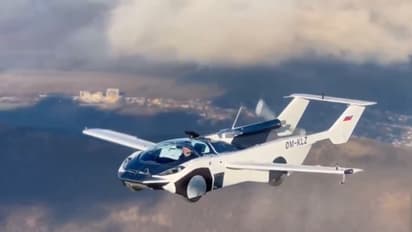World's first flying car that switches to airplane mode in 90 sec, set to hit market in 2026. It is priced at...

Synopsis
Slovakia-based Klein Vision has unveiled its trailblazing invention, the AirCar, a sleek, road-and-sky hybrid engineered to glide through highways and take off from runways.
A scene once confined to science fiction classics like Chitty Chitty Bang Bang may soon become a common sight in European skies. A Slovakian firm gears up to release the world’s first mass-produced flying car.
Slovakia-based Klein Vision has unveiled its trailblazing invention, the AirCar, a sleek, road-and-sky hybrid engineered to glide through highways and take off from runways. This futuristic two-seater, resembling a sports coupe with retractable wings, is expected to hit the market in early 2026.
“AirCar fulfills a lifelong dream” said Stefan Klein, the mastermind behind Klein Vision. “With the launch of our production prototype, we are one step closer to transforming how the world moves – merging the road and the sky into a new dimension of personal mobility.”
AirCar: Specs, price & all you need to know
The AirCar is a mechanical marvel—its wings deploy in under two minutes for flight mode and fold back seamlessly after landing. Capable of accelerating along a 980-foot runway and soaring at speeds up to 155 mph, the vehicle operates on standard petrol and can ascend to a height of 18,000 feet. A propeller situated between the fuselage and tail powers its airborne journey.
While it currently runs on petrol, co-founder Anton Zajac revealed the company’s aspiration to go green: “AirCar will go electric as soon as the energy density of the batteries is good enough.”
Klein Vision has already completed over 170 flight hours and 500+ takeoffs and landings with the original prototype. The upcoming AirCar 2, currently in testing, is scheduled for its maiden voyage this September.
With a price tag starting at $800,000 (£600,000) and soaring up to $1 million (£750,000) depending on the engine specs—buyers can choose between 280, 320, or 340 horsepower—this airborne automobile is a high-end luxury for now. But its creators envision a wide array of uses, from private leisure flights to commercial air-taxi services.
Even celebrities are catching wind of the innovation. French electronic music icon Jean-Michel Jarre became the first passenger to soar in the AirCar last year, calling the journey surreal: “One second you speak to the driver, and next, you are up there in the air – an amazing experience.” He likened the flight to stepping inside a “Jules Verne book.”
British TV presenter James May, of Top Gear fame, also witnessed the AirCar’s prowess first-hand at a Slovakian international airport. “The AirCar has landed. Very rarely am I lost for words, but I am lost for words!” he remarked, clearly astonished.
Back home in Slovakia, the AirCar was awarded the Certificate of Airworthiness in 2022, greenlighting its journey toward mass production and commercial use. Meanwhile, the UK is catching up fast, with £20 million in government funding earmarked for preparing the regulatory infrastructure needed to support flying taxis.
Mike Kane, the UK’s Transport Minister, said, “There will be flying taxis over British skies in just three years' time”, with the first piloted flight expected by 2026.
Despite the excitement, early buyers may face delays in some countries. As of now, the AirCar may not be cleared to fly over British skies in 2026 due to pending approvals.
According to Morgan Stanley, the flying car industry could skyrocket to a $1 trillion market by 2040, potentially reaching a staggering $9 trillion by 2050. Experts believe that these vehicles could transform urban mobility, unclogging road traffic and unlocking the vast, untapped real estate of the skies.